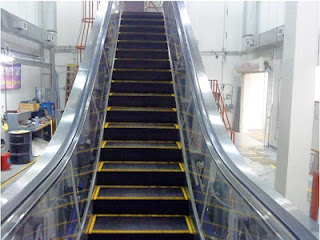The
platforms contain a floor plate provides a place for the passengers to stand
moving stairs and also combplates are an entrance and exit for the passengers
to provide mounting for the comb segments and comb plate switch actuator.
Motors that drive the stairs, top platform contains the motor assembly and the
main drive gear while the bottom holds the step return idler sprocket anchor
the ends of the escalator parts truss. This plate is flush with the finished floor
allow easy access to the machinery below. Moving step at the stationary floor
that is the edge has a series of cleats that resemble the teeth of a comb.
These teeth mesh with matching cleats on the edges of the steps is necessary to
minimize the gap between the stairs which helps prevent objects from getting
caught in the gap. The ends of the truss are attached to the top and bottom
landing platforms via steel or concrete supports. The truss carries all the
straight track sections connecting the upper and lower sections, designed to
carry the entire load of the escalator parts equipment and the steel covering without
shifting more than specified by the contract requirements. The entire structure
is rigid enough to maintain close operating tolerances.
The
guideline to track system step chain is directly pulls the steps from the
bottom platform and back to the top in an endless loop, long the straight
section of the truss, at the top and bottom of the escalator and the two tracks
converge so that the front and back wheels of the steps are almost in a
straight line. This causes the stairs to lay in a flat sheet can easily travel
around the bend in the curved section of track. The tracks carry the steps down
along the underside of the truss until they reach the bottom landing, where
they pass through another curved section of track before exiting the bottom
landing. The tracks separate then the steps assume again to a staircase
configuration. This cycle is repeated continually as the steps are pulled from
bottom to top and back to the bottom. Guidelines are used to track the steps
wheels and step chains in their travel around the escalator truss, the curve
plates at the upper and lower landing sections. They are curved at the upper
and the lower end of the incline to allow smooth transition of steps from the
form of stairs to a horizontal movement to contain the chains and the step
rollers going around them.
The
balustrade consists of the handrail deck provides a convenient handhold while
they are riding the escalator at the chain that is connected to the main drive
gear by a series of pulleys and the exterior supporting structure of the
escalator exterior components extending above the steps and it supports the
handrail designed as interior low deck or interior high. It may also refer to
the individual interior panels and deck covers of the escalator. Each interior
balustrade panel section is individually removable to allow easy access to the
escalator interior for proper maintenance.

No comments:
Post a Comment